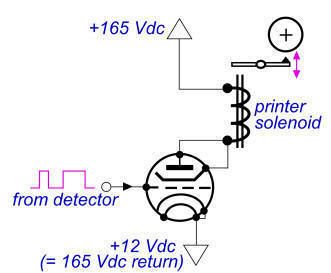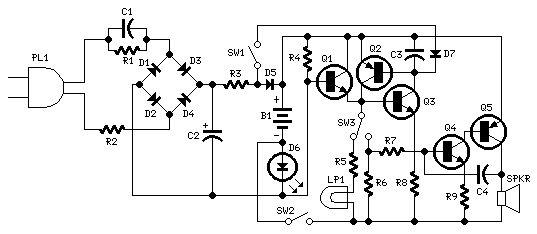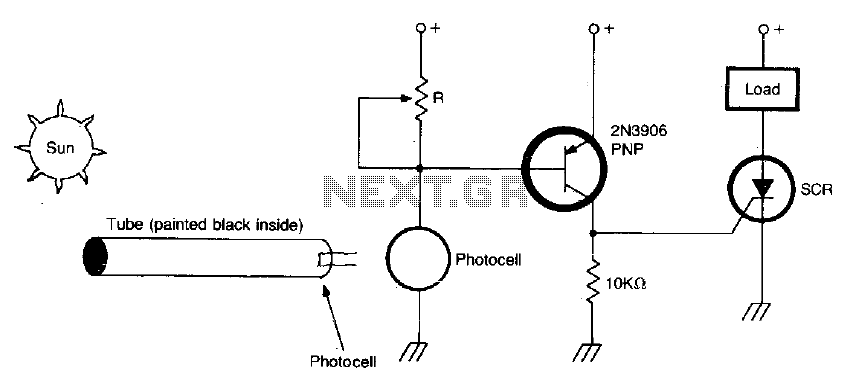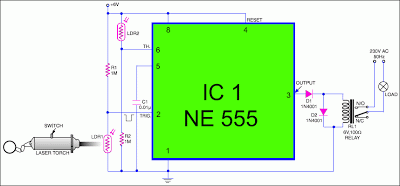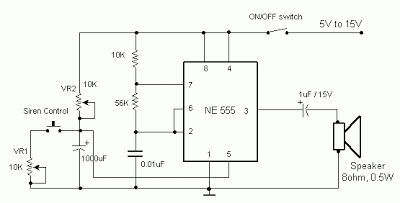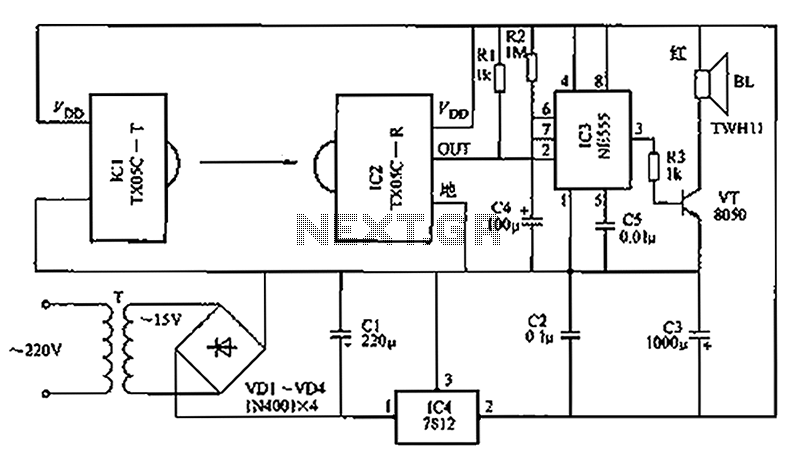
Schematics Touch Activated Alarm
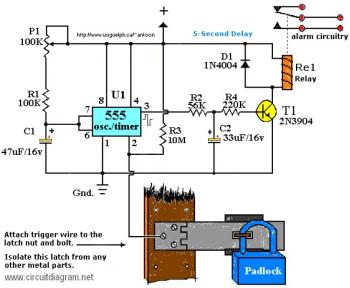
The working voltage of capacitors C1 and C2 should be increased to 25V if a 12V power source is used. A general guideline is that the operating voltage of capacitors should be at least double the supplied voltage; for instance, if the power source is 9V, the minimum voltage rating for the capacitors should be 18V. Transistor T1 can be replaced with any suitable equivalent. An appropriate relay should be selected for the project, and if space is not a constraint, any size relay can be utilized. This circuit was designed to prevent students from tampering with security cameras in computer labs at a university. It is important to ensure that the metal casing is not grounded, although the schematic allows for connection to any type of metal surface. A 12V DC power supply is recommended. A suitable relay should be chosen based on specific requirements. A RESET switch (normally closed) can be added between the positive supply and the designated point in the schematic. The trigger (touch) wire connects to pin 2 of the 555 timer and activates the relay through body resistance when touched. The touching component must be clean to ensure good contact with the trigger wire. This circuit may not be suitable for all applications. Notably, pin 5 is not included in the schematic as it is not necessary. In noisy environments, a small ceramic capacitor can be placed between pin 5 and ground, although its inclusion is optional. Additionally, there is an approximate 5-second delay built into the circuit before the relay activates to prevent false triggering, such as from an unintended source.
The circuit description outlines a touch-sensitive relay activation system utilizing a 555 timer IC. The primary function of this circuit is to deter unauthorized access to security cameras in computer labs by requiring physical contact to activate the relay. The design incorporates capacitors C1 and C2, which must be rated for higher voltages than the supplied voltage to ensure reliability and safety. The use of a 12V DC power supply is standard, and the relay should be selected based on the load it will control and the physical space available for installation.
The 555 timer operates in monostable mode, where pin 2 acts as the trigger input. When a person touches the designated area, the body resistance completes the circuit, momentarily pulling pin 2 low, which activates the timer. The output from pin 3 will then energize the relay, allowing it to control the connected load. The inclusion of a RESET switch provides a manual means to deactivate the relay if necessary, enhancing the functionality of the circuit.
To optimize performance, attention should be paid to the cleanliness of the contact point, as poor contact can lead to unreliable operation. The optional capacitor connected to pin 5 serves as a noise filter, which can be beneficial in environments with electrical interference. The built-in delay feature is crucial for preventing accidental relay activation, adding a layer of security against unintentional triggering.
Overall, this circuit combines simple components to create an effective security measure, demonstrating practical applications of basic electronic principles in real-world scenarios.C1/C2`s working voltage ought to be elevated to 25V in the event you decide to go with a 12V power source. Rule of thumb: the operating voltage of capacitors are at least double the supplied voltage, in other words, if the power source is 9 Volt, your capacitor(s) is a minimum of 18V.
Transistor T1 could be any approximate substitute. * Use any a ppropriate relay for the project and if you`re not tight on area, use any size. I`ve build this specific circuit to prevent students from fiddling using the security cameras in pc labs at the University I`m employed. I made sure the metal casing was not grounded. But as being the schematic shows you are able to essentially hook it as much as any type of metal surface.
I utilized a 12-vdc power supply. Use any suitable relay to deal with your specifications. A `RESET` switch (Normally Closed) can be added between the constructive and also the `arrow-with-the-+`. The trigger (touch) wire is connected to pin 2 of the 555 and will trigger the relay, using the body resistance, when touched.
It is apparent that the `touching` component has to be clean and can make good contact using the trigger wire. This particular circuit might not be suitable for all applications. Just in case you wonder why pin 5 is not listed within the schematic diagram ; it is not really required.
In particular noisy circumstances a little ceramic capacitor is placed between pin 5 and ground. It will no harm to put one or leave it out. Additional note: For those of you who didn`t discover, there`s an approximate 5-second delay build-in before activation of the relay to avoid false triggering, or perhaps a `would-be` thief, and so on. 🔗 External reference
The circuit description outlines a touch-sensitive relay activation system utilizing a 555 timer IC. The primary function of this circuit is to deter unauthorized access to security cameras in computer labs by requiring physical contact to activate the relay. The design incorporates capacitors C1 and C2, which must be rated for higher voltages than the supplied voltage to ensure reliability and safety. The use of a 12V DC power supply is standard, and the relay should be selected based on the load it will control and the physical space available for installation.
The 555 timer operates in monostable mode, where pin 2 acts as the trigger input. When a person touches the designated area, the body resistance completes the circuit, momentarily pulling pin 2 low, which activates the timer. The output from pin 3 will then energize the relay, allowing it to control the connected load. The inclusion of a RESET switch provides a manual means to deactivate the relay if necessary, enhancing the functionality of the circuit.
To optimize performance, attention should be paid to the cleanliness of the contact point, as poor contact can lead to unreliable operation. The optional capacitor connected to pin 5 serves as a noise filter, which can be beneficial in environments with electrical interference. The built-in delay feature is crucial for preventing accidental relay activation, adding a layer of security against unintentional triggering.
Overall, this circuit combines simple components to create an effective security measure, demonstrating practical applications of basic electronic principles in real-world scenarios.C1/C2`s working voltage ought to be elevated to 25V in the event you decide to go with a 12V power source. Rule of thumb: the operating voltage of capacitors are at least double the supplied voltage, in other words, if the power source is 9 Volt, your capacitor(s) is a minimum of 18V.
Transistor T1 could be any approximate substitute. * Use any a ppropriate relay for the project and if you`re not tight on area, use any size. I`ve build this specific circuit to prevent students from fiddling using the security cameras in pc labs at the University I`m employed. I made sure the metal casing was not grounded. But as being the schematic shows you are able to essentially hook it as much as any type of metal surface.
I utilized a 12-vdc power supply. Use any suitable relay to deal with your specifications. A `RESET` switch (Normally Closed) can be added between the constructive and also the `arrow-with-the-+`. The trigger (touch) wire is connected to pin 2 of the 555 and will trigger the relay, using the body resistance, when touched.
It is apparent that the `touching` component has to be clean and can make good contact using the trigger wire. This particular circuit might not be suitable for all applications. Just in case you wonder why pin 5 is not listed within the schematic diagram ; it is not really required.
In particular noisy circumstances a little ceramic capacitor is placed between pin 5 and ground. It will no harm to put one or leave it out. Additional note: For those of you who didn`t discover, there`s an approximate 5-second delay build-in before activation of the relay to avoid false triggering, or perhaps a `would-be` thief, and so on. 🔗 External reference
